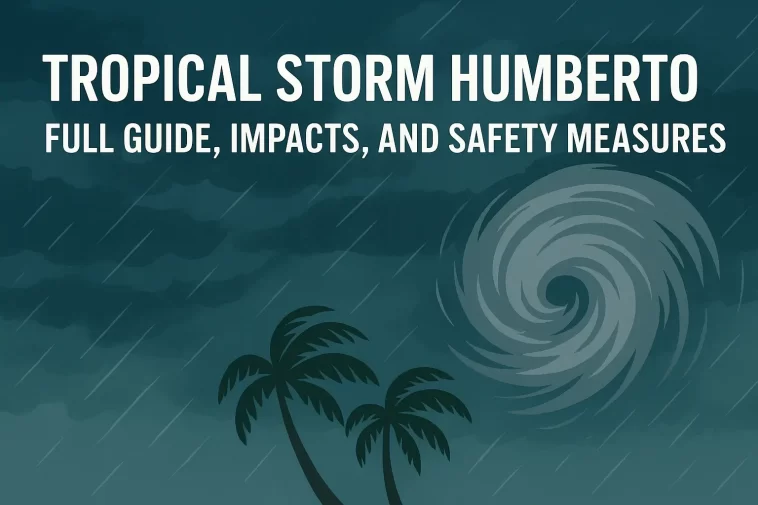Every year, the Atlantic hurricane season brings a wave of uncertainty and danger for millions of people living in coastal areas. Among the storms that have gained international attention, Tropical Storm Humberto stands out as a powerful reminder of how quickly weather conditions can change and disrupt daily life. While Humberto has not yet reached hurricane status, experts warn that its strength, speed, and unpredictability make it a serious threat.
In this article, we will explore how Tropical Storm Humberto formed, the current trajectory, its possible impacts on communities, and the best safety measures to take. Additionally, we will discuss the environmental and economic consequences of such tropical systems and why preparation is crucial in the era of climate change.
Formation of Tropical Storm Humberto
Tropical storms often begin as clusters of thunderstorms over the warm Atlantic waters. With the right combination of humidity, temperature, and wind conditions, these disturbances can strengthen into organized systems. Humberto followed this exact path:
- Originating from a tropical wave,
- Feeding on warm sea surface temperatures,
- Gradually increasing in wind speed and rainfall intensity.
Meteorologists quickly classified it as a tropical storm once its winds exceeded 39 mph. While it remains below hurricane force (74 mph or more), the dangers of flooding, heavy rain, and storm surge should not be underestimated.
Current Status and Projected Path
As of the latest updates, Tropical Storm Humberto is moving across the Atlantic with sustained winds that continue to rise. Forecast models show that the storm could strengthen further, depending on ocean conditions and wind shear levels.
The predicted path suggests that Humberto could threaten island nations in the Caribbean before shifting toward parts of the southeastern United States. Even a small shift in trajectory can dramatically alter which areas are most affected, which is why constant monitoring is essential.
Key points about Humberto’s movement:
- Sustained winds currently around 45–60 mph.
- Potential for torrential rainfall in coastal and low-lying areas.
- High surf and rip current risks along the Atlantic coastline.
- Flooding hazards expected in vulnerable regions.
Potential Impacts on Communities
1. Coastal Flooding
Storm surges combined with high tides can lead to dangerous coastal flooding. Homes, roads, and businesses in low-lying areas face the highest risk.
2. Heavy Rainfall
Humberto’s rainfall could reach several inches in just a few hours. This increases the likelihood of flash floods, landslides in hilly areas, and overwhelmed drainage systems.
3. Power Outages
Strong winds are capable of knocking down power lines and disrupting electricity for thousands of residents. Restoring power after a tropical storm often takes days.
4. Transportation Disruptions
Airports, seaports, and highways may be forced to close, leading to delays in travel and shipping. Communities that rely on imports could face temporary shortages of goods.
Safety and Preparedness Tips
Authorities and weather experts strongly recommend that residents prepare early for Tropical Storm Humberto’s potential impacts. Preparation can save lives.
- Stay informed: Follow updates from the National Hurricane Center and local weather services.
- Create an emergency kit: Include bottled water, canned food, medications, flashlights, and batteries.
- Secure your property: Bring in outdoor furniture, secure loose items, and check your roof and windows.
- Develop an evacuation plan: Know the nearest shelters and have a plan for pets and elderly family members.
- Charge devices and backup power sources: Communication is vital during storms.
Environmental and Economic Consequences
Tropical storms like Humberto do not only affect people in the short term; their long-lasting impacts ripple through economies and ecosystems.
- Environmental Effects: Heavy rainfall can lead to soil erosion, river flooding, and damage to coral reefs. Wildlife habitats may also be disturbed.
- Economic Challenges: Communities dependent on tourism, fishing, and agriculture face significant losses. Storm damage to hotels, airports, and ports can reduce income for months.
- Infrastructure Costs: Rebuilding damaged roads, bridges, and electrical systems requires major investment and international aid.
Climate scientists also highlight that climate change may be fueling stronger and more frequent tropical storms, making preparedness more important than ever.
Final Thoughts
Tropical Storm Humberto is a reminder that even storms below hurricane strength can pose severe risks to people, property, and the environment. Preparedness, awareness, and community cooperation are the best defenses against these unpredictable weather systems.
By following official guidance, stocking up on essentials, and staying alert to changes in the forecast, residents can reduce risks and ensure their families’ safety. Whether or not Humberto intensifies into a hurricane, its impact will be felt across multiple regions, and the lessons learned will remain valuable for future storms.

